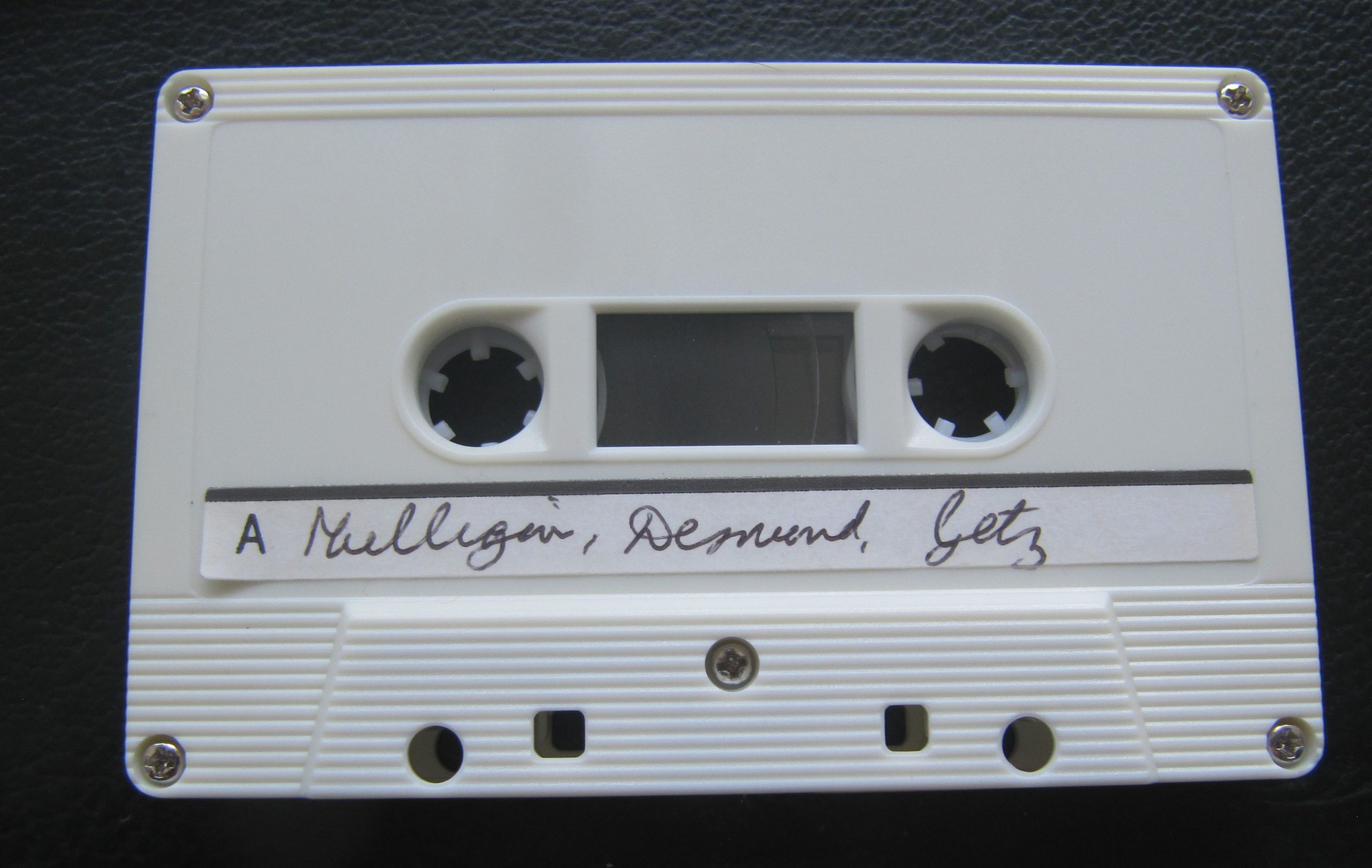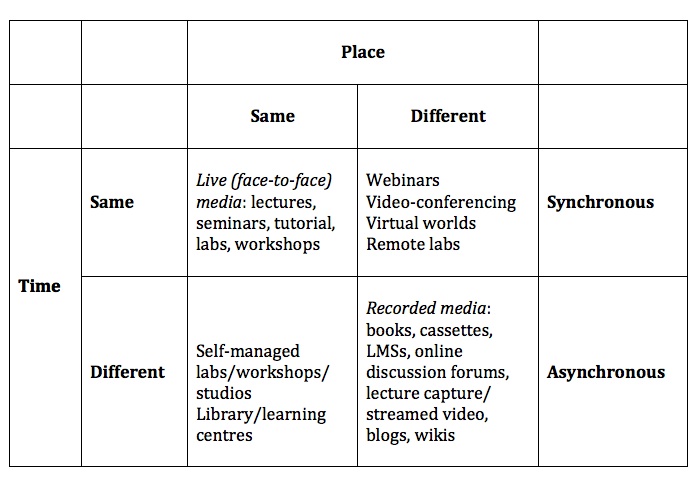61

![]()
Different media and technologies operate differently over space and time. These dimensions are important for both facilitating or inhibiting learning, and for limiting or enabling more flexibility for learners. There are actually two closely related dimensions here:
- live or recorded
- synchronous or asynchronous
7.6.1 Live or recorded
These are fairly obvious in their meaning. Live media by definition are face-to-face events, such as lectures, seminars, and one-on-one face-to-face tutorials. A live event requires everyone to be present at the same place and time as everyone else. This could be a rock concert, a sports event, or a lecture. Live events, such as for instance a seminar, work well when personal relations are important, such as building trust, or for challenging attitudes or positions that are emotionally or strongly held (either by students or instructors.) The main educational advantage of a live lecture is that it may have a strong emotive quality that inspires or encourages learners beyond the actual transmission of knowledge, or may provide an emotional “charge” that may help students shift from previously held positions. Live events, by definition, are transient. They may be well remembered, but they cannot be repeated, or if they are, it will be a different experience or a different audience. Thus there is a strong qualitative or affective element about live events.
Recorded media, on the other hand, are permanently available to those possessing the recording, such as a video cassette or an audio cassette. Books and other print formats are also recorded media. The key educational significance of recorded media is that students can access the same learning material an unlimited number of times, and at times that are convenient for the learner.
Live events of course can also be recorded, but as anyone who has watched a live sports event compared to a recording of the same event knows, the experience is different, with usually a lesser emotional charge when watching a recording (especially if you already know the result). Thus one might think of “live” events as “hot” and recorded events as “cool.” Recorded media can of course be emotionally moving, such as a good novel, but the experience is different from actually taking part in the events described.
7.6.2 Synchronous or asynchronous
Synchronous technologies require all those participating in the communication to participate together, at the same time, but not necessarily in the same place.
Thus live events are one example of synchronous media, but unlike live events, technology enables synchronous learning without everyone having to be in the same place, although everyone does have to participate in the event at the same time. A video conference or a webinar are examples of synchronous technologies which may be broadcast “live,” but not with everyone in the same place. Other synchronous technologies are television or radio broadcasts. You have to be “there” at the time of transmission, or you miss them. However, the “there” may be somewhere different from where the teacher is.
Asynchronous technologies enable participants to access information or communicate at different points of time, usually at the time and place of choice of the participant. All recorded media are asynchronous. Books, DVDs, on-demand YouTube videos, lectures recorded through lecture capture and available for streaming on-demand, and online discussion forums are all asynchronous media or technologies. Learners can log on or access these technologies at times and places of their own choosing.
Figure 7.6.2 illustrates the main differences between media in terms of different combinations of time and place.

![]()
7.6.3 Why does this matter?
Overall there are huge educational benefits associated with asynchronous or recorded media because the ability to access information or communicate at any time offers the learner more control and flexibility. The educational benefits have been confirmed in a number of studies. For instance, Means et al. (2010) found that students did better on blended learning because they spent more time on task because the online materials were always available to the students.
Research at the Open University found that students much preferred to listen to radio broadcasts recorded on cassette than to the actual broadcast, even though the content and format were identical (Grundin, 1981; Bates et al., 1981). However, even greater benefits were found when the format of the audio was changed to take advantage of the control characteristics of cassettes (stop, replay). It was found that students learned more from “designed” cassettes than from cassette recordings of broadcasts, especially when the cassettes were coordinated or integrated with visual material, such as text or graphics. This was particularly valuable, for instance, in talking students through mathematical formulas (Durbridge, 1983).
This research underlines the importance of changing design as one moves from synchronous to asynchronous technologies. Thus we can predict that although there are benefits in recording live lectures through lecture capture in terms of flexibility and access, or having readings available at any time or place, the learning benefits would be even greater if the lecture or text was redesigned for asynchronous use, with built-in activities such as tests and feedback, and points for students to stop the lecture and do some research or extra reading, then returning to the teaching.
The ability to access learning materials on-demand (recorded lectures or webinars, learning management systems, websites, social media) is particularly important for increasing access and flexibility for learners, especially those working as well as studying, for those with young families, or for students with long commutes. Thus there should be clearly justified pedagogical benefits that could not be provided by the use of technology if students must be present either in the same place or at the same time as an instructor. In particular, what are the social or pedagogical reasons why students should come to the school or campus or be present at a set time when so much teaching and learning can now be done asynchronously?
The ability to access media asynchronously through recorded and streamed materials is one of the biggest changes in the history of teaching, but the dominant paradigm in higher education is still the live lecture or seminar. There are, as we have seen, some advantages in live media, and direct inter-personal contact, but they need to be used more selectively to exploit their unique advantages or affordances.
7.6.4 The significance of the Internet
Broadcast/communicative and synchronous/asynchronous are two separate dimensions. By placing them in a matrix design, we can then assign different technologies to different quadrants, as in Figure 7.6.4 below. (I have included only a few – you may want to place other technologies on this diagram):

![]()
Why the Internet is so important is that it is an encompassing medium that embraces all these other media and technologies, thus offering immense possibilities for teaching and learning. This enables us, if we wish, to be very specific about how we design our teaching so that we can exploit all the characteristics or dimensions of technology to fit almost any learning context through this one medium.
7.6.5 Conclusion
It should be noted at this stage that although I have identified some strengths and weaknesses of the four characteristics of broadcast/communicative, and synchronous/asynchronous media, we still need an evaluative framework for deciding when to use or combine different technologies. This means developing criteria that will enable us to decide within specific contexts the optimum choice of technologies.
References
Bates, A. (1981) ‘Some unique educational characteristics of television and some implications for teaching or learning‘ Journal of Educational Television Vol. 7, No.3
Durbridge, N. (1983) Design implications of audio and video cassettes Milton Keynes: Open University Institute of Educational Technology (out of print)
Grundin, H. (1981) Open University Broadcasting Times and their Impact on Students’ Viewing/Listening Milton Keynes: The Open University Institute of Educational Technology (out of print)
Means, B. et al. (2009) Evaluation of Evidence-Based Practices in Online Learning: A Meta-Analysis and Review of Online Learning Studies Washington, DC: US Department of Education
Activity 7.6 Time and space dimensions of technology
1. Does this categorization of technologies make sense to you?
2. Can you easily place other media or technologies into Figures 7.6.2 and 7.6.4? What media or technologies don’t fit? Why not?
3. Can you imagine a situation where a podcast might be a better choice for teaching and learning than virtual reality (assuming students have access to both technologies)? And can you imagine the opposite (of where virtual reality would be better than an audio-cassette)? What are the defining criteria or conditions?
For my comments on the last question, click on the podcast below:
